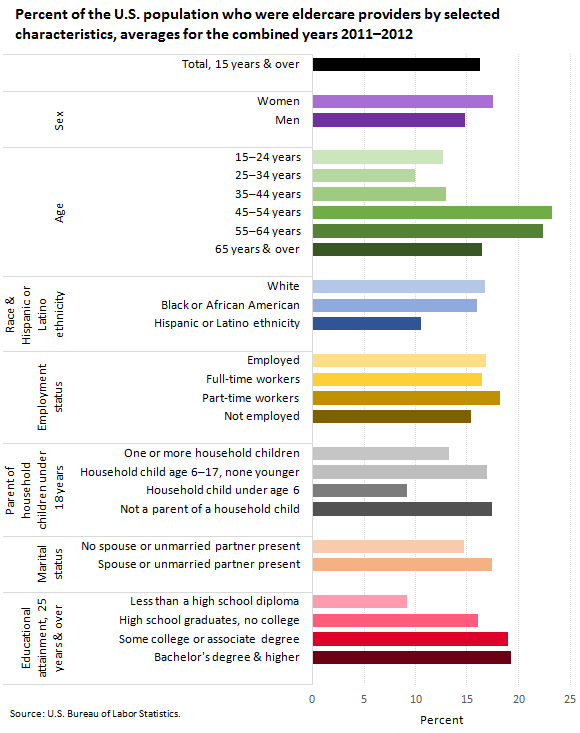An official website of the United States government
 United States Department of Labor
United States Department of Labor
Sixteen percent of the U.S. civilian noninstitutional population age 15 and over (39.6 million people) provided unpaid eldercare in 2011 and 2012. Eldercare providers are defined as individuals who provide unpaid care to someone age 65 or older who needs help because of a condition related to aging.

| Characteristic | Percent |
|---|---|
Total, 15 years & over | 16.1 |
Sex | |
Women | 17.4 |
Men | 14.7 |
Age | |
15 to 24 years | 12.5 |
25 to 34 years | 9.8 |
35 to 44 years | 12.8 |
45 to 54 years | 23.1 |
55 to 64 years | 22.2 |
65 years and over | 16.3 |
Race and Hispanic or Latino ethnicity | |
White | 16.6 |
Black or African American | 15.8 |
Hispanic or Latino ethnicity | 10.4 |
Employment status | |
Employed | 16.7 |
Full-time workers | 16.3 |
Part-time workers | 18.1 |
Not employed | 15.2 |
Parent of household children under 18 years | |
Parent of one or more household children | 13.1 |
Parent of a household child age 6 to 17, none younger | 16.8 |
Parent of a household child under age 6 | 9.0 |
Not a parent of a household child | 17.3 |
Marital status | |
No spouse or unmarried partner present in household | 14.6 |
Spouse or unmarried partner present in household | 17.3 |
Educational attainment, 25 years and over | |
Less than a high school diploma | 9.0 |
High school graduates, no college | 15.9 |
Some college or associate degree | 18.8 |
Bachelor's degree and higher | 19.1 |
NOTE: Not all race categories are shown. Persons of Hispanic or Latino ethnicity may be of any race. | |
During the 2011–2012 period, 17.4 percent of women provided eldercare, compared with 14.7 percent of men.
Individuals ages 45 to 54 and 55 to 64 were the most likely to provide eldercare (23.1 percent and 22.2 percent, respectively), followed by those age 65 and over (16.3 percent).
The eldercare provider rates for Whites and Blacks were 16.6 percent and 15.8 percent, respectively. For persons of Hispanic or Latino ethnicity (who may be of any race) the rate was 10.4 percent.
Overall, 16.7 percent of workers provided eldercare. Part-time workers did so at a higher rate (18.1 percent) than did full-time workers (16.3 percent); those not employed provided eldercare at a lower rate (15.2 percent).
People without children at home and parents with children age 6 to 17 (and none younger) provided eldercare at higher rates (17.3 percent and 16.8 percent, respectively) than parents with children under age 6 (9.0 percent). Those with a spouse or unmarried partner present provided eldercare at a higher rate (17.3 percent) than those without a spouse or partner present (14.6 percent).
Among persons age 25 and over, those with higher levels of education spent more time caring for those over 65. Among those with a bachelor’s degree and higher, 19.1 percent provided eldercare and among those with some college or associate degree the rate was 18.8 percent. High school graduates and those with less than a high school diploma provided eldercare at lower rates (15.9 percent and 9.0 percent).
These data are from the American Time Use Survey. To learn more, see "Unpaid Eldercare in the United States — 2011–2012 Data from the American Time Use Survey" (HTML) (PDF), news release USDL-13-1886.
Bureau of Labor Statistics, U.S. Department of Labor, The Economics Daily, Eldercare in 2011 and 2012 at https://www.bls.gov/opub/ted/2013/ted_20130920.htm (visited January 09, 2026).

